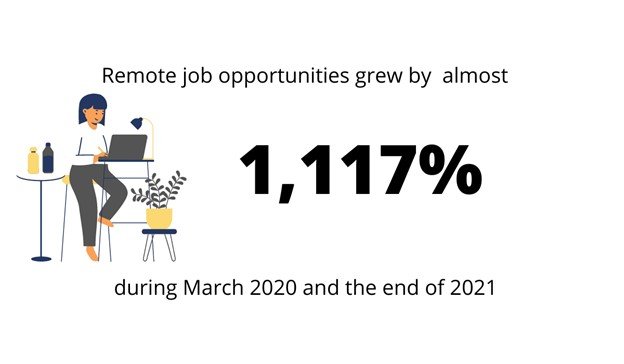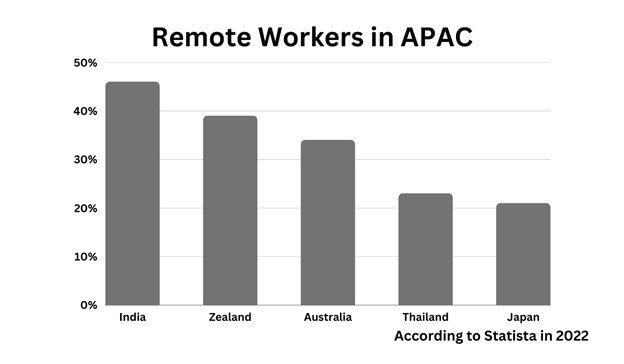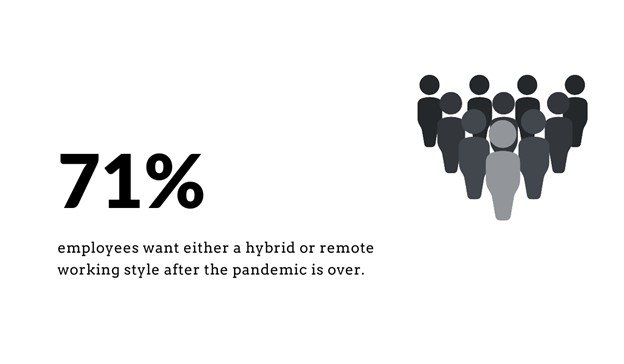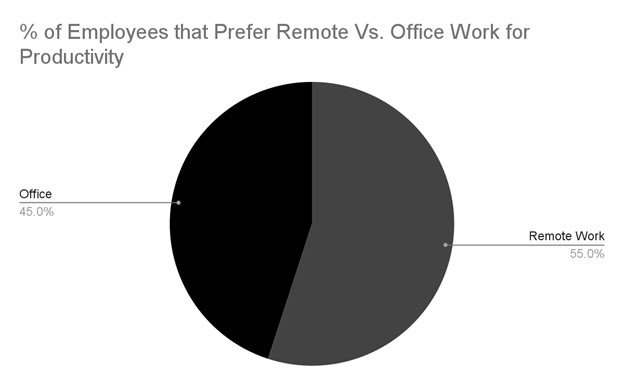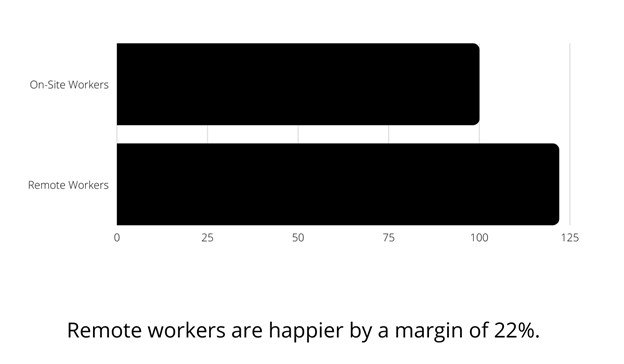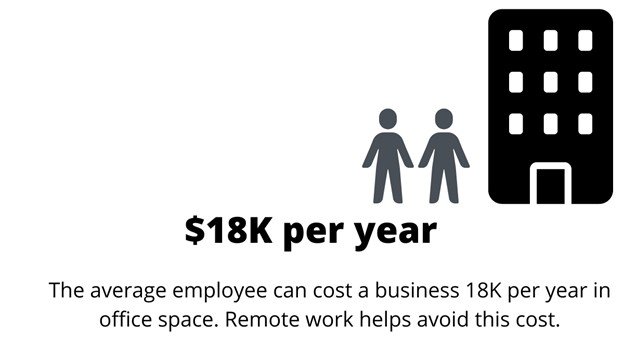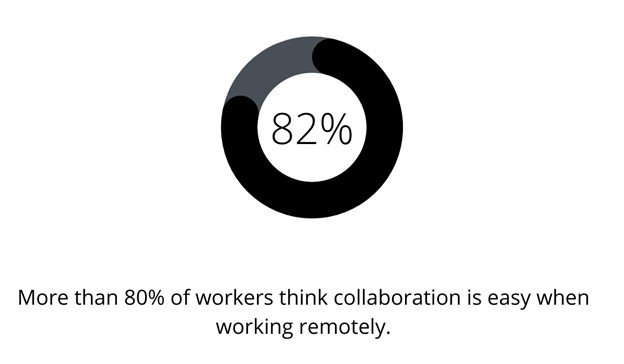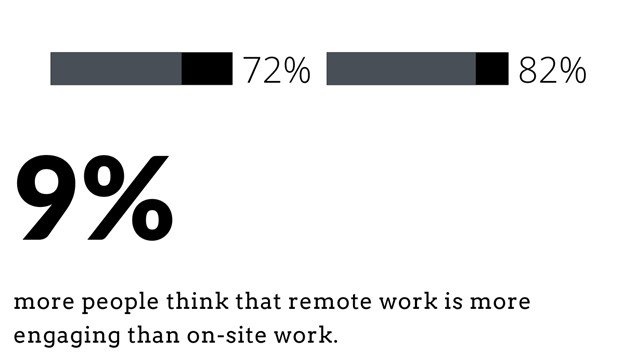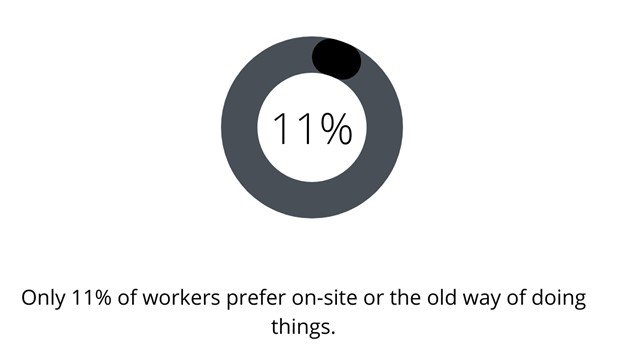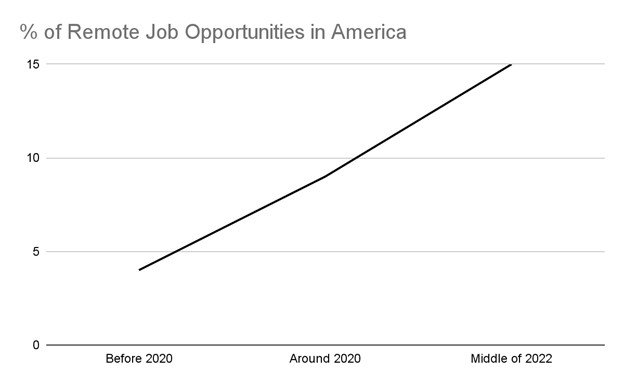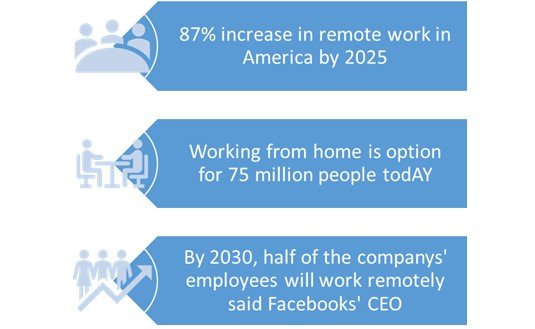As the pandemic rolled in early 2020, people faced dire challenges in making a living.
However, it also brought in some new opportunities. One of these novel opportunities was a renewed focus on remote work. Although remote work was still a thing well before the pandemic, its time to shine came afterwards.
Remote work has held up many businesses from going bankrupt. It has allowed people to work and do things that office work did not allow. This includes flexible working hours and being in charge of one’s schedule. The freedom to choose your working hours introduced new dynamics to the business.
Let’s dive into some of the stats around remote work. They should help you understand how it has impacted people’s lives, how it is changing businesses and its role in regard to both people and businesses in the future.
Updated Remote Work Statistics
Key Takeaways
- Post-pandemic, the percentages of the number of remote workers have risen drastically.
- Many companies have invested in support tools to enable effective remote work.
- Overall, employees are satisfied with the results of remote work and plan on continuing remote or even hybrid work schedules in the future.
- A considerable percentage of people who switched jobs seek flexible work policies, namely hybrid work hours.
- Employers generally want their staff back in the office, but a considerable percentage agree that remote work is here to stay. Thus, they encourage flexible work policies in their organizations.
- Different regions have varied trends on remote work in 2023; however, a general increase has been observed from 2021 to 2022-23.
- Employees enjoy the positive impacts of remote work, such as better performance, improved mental health, and high-quality results.
- Employers know they are ensuring the safety of their staff with flexible work policies. They also receive better results as employees are more productive at home, and they attract more employees seeking such favorable policies.
- Many professions can be practised at home, such as project manager roles and tech roles, including I.T. specialists, software engineers, and web designers.
- The future of remote work seems bright as the world is adopting hybrid work models. Moreover, the advancements in tech and the costs that can be saved with such policies undoubtedly benefit employers and employees.
Key Remote Work Statistics
For Employees
- LinkedIn said remote job options grew by more than 1100% between March 2020 and the end of 2021. This was a massive leap from about 1.4% of jobs in the U.S. offering remote work at the start of the pandemic to about 17% of jobs offering remote work a year into it.
- According to ZDNet, Gartner estimates that fully remote and hybrid workers are expected to account for 71% of the U.S. workforce in 2023.
- Based on Gallup’s COVID-19 Panel tracking survey of U.S. adults since the start of the pandemic, almost six out of ten (58%) of working adults in America are working part-time remote jobs.
- At least 92% of the employees anticipate working from home at least once a week, and 80% expect to work at least three days a week.
- FlexJobs says businesses have lost around $600 billion yearly on workplace distractions. Much of that money can be saved from remote working and enhancing the employees’ productivity at home.
- A study conducted by Stanford University involving CTrip, a NASDAQ-listed 16,000- employee Travel agency, found that performance in remote work environments increased by 13%.
For Employers
- Owl Labs collaborated with Global Workplace Analytics in their annual ‘State of Remote Work’ report. They surveyed over 2000 full-time workers in the United States between the ages 21 and 65 in September 2021 and discovered the following:
- 46% of employees said they would be willing to take a 5% pay cut to work from home at least some of the time.
- According to a FlexJobs survey of over 4000 people, 24% of employees would take a pay cut of 10% to 20% to work remotely as much as they want.
- Global Workplace Analytics says a half-time remote employee can save up to $11,000 annually.
- The annual Owl Labs 2021 ‘State of Remote Work’ Report found that 55% of respondents said they work more hours from home than in the office. So employers can get more out of their workers using remote work.
- Bloomberg discovered that if the boss of a company isn’t flexible about remote work, 39% of employees are likely to change jobs.
- Remote work can reduce 54 million tons of carbon emissions into the atmosphere each year.
How Has Remote Work Affected Employees Across the World?
1. Remote Work in Europe
A report was published by Okta named the “Okta Hybrid Work Report 2023”. It contains the results of a detailed survey by Statista on behalf of Okta in 2022.
It states that 45% of European organizations allow their employees to work remotely for up to three days per week.
63% of respondents stated that they associate remote work with higher productivity.
The same report states that hybrid work is directly proportional to employee well-being. One in three European employees was in the middle of switching jobs, while 42% left their current employer searching for a better workplace experience.
When asked whether their organizations had adopted remote work policies, more than three-fourths (77%) of those surveyed said that their organization supported flexible working hours.
However, 75% of organizations in the E.U. plan to reassess their hybrid work model within the next 12 months, as hybrid work is still a matter of reconsideration for employers.
Reuters published an article on February 15, 2023, quoting extensive European Central Bank study data. It stated that 30% of workers had work-from-home preferences that exceeded what they expected their employers to offer.
It also stated that workers who commute more than one hour each way prefer 10 work-from-home days per month (four more than workers whose commute time is less than 15 minutes).
2. Remote Work Statistics in Asia
A blog called “Navigating the future of hybrid work in APAC” on Google Workspace provides details on remote employment in the Asia Pacific. It is dated November 24, 2021.
The APAC survey respondents wanted greater location flexibility (70%) and time flexibility (71%). Note that this requirement exceeds what employers are willing to provide.
IDC is the leading worldwide source for market insights, consulting, and industry events in information technology, telecommunications, and consumer technology. One of their reports states that 56% of Asia/Pacific employees preferred to continue flexible work beyond the pandemic.
More than 70% of the employees claimed their productivity was higher or around the same level compared to that before the pandemic.
According to Statista, in a 2022 survey conducted among employees in the Asia-Pacific region, respondents mostly preferred to work in hybrid mode in the future. The percentages of remote workers are comparable to those of hybrid workers. Some of the APAC countries with the highest rates of remote workers are shown in the figure below:
3. Remote Work in the USA
As we mentioned above, Owl Labs did a study in the U.S. in late 2021 for its annual report on the state of remote work in the United States. The report shows us how remote work has evolved.
During the pandemic, almost 70% of full-time employees would work from home some of the time.
90% of Owl Lab’s respondents say they were either as productive or more productive while working remotely. Does that mean employers get more out of their employees? Maybe. Because 55% of these American employees say, they work more hours remotely.
84% of employees say that working remotely would make them happier. Why? It might have something to do with things like virtual meetings. 70% of employees say virtual meetings are less stressful. Similarly, 64% of employees prefer hybrid meetings.
In fact, employees like remote work so much that some of them would be willing to take a pay cut for it. Between July and August 2021, FlexJobs surveyed 4,612 people on their platform about job plans, and here is what they found from the respondents.
- Almost 45% knew somebody who had already quit or was planning to quit their job due to in-person work requirements.
- 29% were looking for a new job that allows remote work.
- 17% would only quit their job if it offered some remote work options.
- 21% would give up some vacation time in order to work remotely.
- Almost a quarter of the employees would take a pay cut of 10% to 20% to work remotely as much as they want.
As of the start of COVID-19, 81% of employees expect that their employer will continue to encourage remote work. On the same note, 59% said they would want to work for a company that allowed for remote work.
Similarly, 33% of employees from the same Owl Lab survey unflinchingly said they would not work for their employers after the pandemic if remote work was not on the table. That excludes 18% of respondents who remain undecided on what they would do under the circumstance. Sum that up, and you potentially have almost half of your workforce threatening to leave if they can not work remotely.
In the middle, you have 71% of employees want either a hybrid or remote working style after the pandemic is over.
States with the Highest Ratio of Remote Workers
FlexJobs compared the number of remote jobs to the number of job seekers between 2020 and 2021 in their database. They found that the ratio of remote jobs to job seekers goes down as you move down the following list of states:
- Rhode Island
- Washington, DC
- Delaware
- North Dakota
- Maine
- Vermont
- South Dakota
- New Hampshire
- West Virginia
- Nebraska
- Wyoming
- Utah
- Connecticut
- Kentucky
- Massachusetts
- Mississippi
- Idaho
- Arkansas
- Oregon
- Minnesota
What Are the Benefits of Remote Work?
There are many benefits of remote work for everybody involved. Let’s look at them both from the perspective of employees and employers.
For Employees
1. Improved Quality of Life
Flex Job surveyed over 800 US employees with flexible work options like remote work, freelancing or working part-time, etc. They also polled employees who did not have flexible work options. The goal was to see how much of an impact flexible work options have on an employee’s work-life balance.
48% of the respondents said they had a good work-life balance. On the other hand, only 36% of employees who had no flexible work possibilities said they had a good work-life balance.
So giving employees flexible work options, which is usually only possible when they are working remotely, increases the chances of them having a healthy work-life balance by about 30%.
Furthermore, two-thirds of the remote workers surveyed showed the intention that they would not prefer to come back to offices.
2. Saved Time on Travelling to Offices
Researchers from MIT, Stanford, and the University of Chicago asked 4000 workers to share work details of the days they were working from the office compared to the days they worked from home.
The result showed that office workers took 28 minutes to prepare themselves for work while remote workers only took 19 minutes. In addition, remote work employees use 20 minutes of each hour they save from commuting to do stuff related to their primary jobs.
3. Improved Mental Health
A survey by Mental Health America (MHA) in 2021 discovered that 77% of their study sample (of about 5000 surveys) want flexible work options to improve their mental and physical health.
An additional study of 17,000 employees discovered that employees in an unhealthy workplace tend to experience higher stress levels. They also tend to have lower engagement in their work.
According to an analysis by the Integrated Benefits Institute (IBI), many executives (64 per cent) stated that remote work had an adverse effect on their employee’s mental health in 2022, up from 55 per cent the previous year.
Similarly, 82% of American employees say working from home after the pandemic is better for their mental health. This is according to the annual 2021′ State of Remote Work’ report by Owl Labs.
For Employers
1. Productivity
As the key stats mention, some studies or reports show that remote work can be more productive.
For example, there was an experiment by Stanford University involving CTrip, a 16,000-employee, NASDAQ-listed Chinese travel agency. The experiment found that performance in remote work environments improved by 13% compared to the norm. A similar study by Owl Labs in 2021 found that 55% of respondents said that they work even more hours from home than they do in the office.
On the same note, businesses have lost around $600 billion per year on workplace distractions, according to FlexJobs. Much of that money can be saved from remote working and enhancing the employees’ productivity at home.
2. Saving Lives
An economist from the University of California, Berkeley, undertook an analysis. He looked at the growth rate of case numbers before and after various lockdown measures were introduced in six countries. These included the U.S., China, France, South Korea, Italy, and Iran.
All of these countries employed vastly different measures to curb the spread of the pandemic. And according to The Scientist,
“The most effective measure, they found, was getting people not to travel to work, while school closures had relatively little effect.”
Furthermore,
“In total, his group estimated that combined interventions prevented or delayed about 62 million confirmed cases in the six countries studied, or about 530 million total infections.”
Logically, a considerable chunk of those saved lives is in the U.S. in proportion to its population to the total of the six countries.
3. Attracting and Retaining Talent
People can often get job offers they would like to accept. There’s just one problem; the company is quite literally far, far away.
Thanks to remote work, people can work for distant companies without ever having to move. This works in the employer’s favour as well. That is because remote work allows employers to attract widespread talent. In other words, companies now have a bigger and better pool of employees to pick from.
Similarly, as we mentioned above, surveys or reports by both FlexJobs and Owl Labs show that employees may take a pay cut just so they can work remotely.
Does Remote Work Really Increase Productivity?
According to Buffer’s “State of Remote Work 2023”, 36% of remote workers found it easier to excel in their careers when working remotely. In 2022, this figure was at 14%. 75% of the respondents also stated that this was because when working from home, employees are assessed based on their output and not the number of hours they spend in the office.
A similar study by Owl Labs in 2021 found that 55% of respondents said they work more hours from home than in the office.
According to the same study, only 36% of respondents said the office is the ideal place for individual work.
The same Owl Labs report found that 32% of respondents claimed they would quit their jobs if they couldn’t work from home.
Furthermore, 52% of American-listed companies agreed that their employees’ productivity increased while working from home.
Additionally, a survey by Pew Research Center states that at U.S. workplaces, about a third (35%) of workers with jobs that can be done remotely are working from home all of the time. This is down from 43% in January 2022.
According to FlexJobs, businesses have lost around $600 billion per year on workplace distractions. Much of that money can be saved from remote working and enhancing the employees’ productivity at home.
Furthermore, a study conducted by Stanford University found that performance in remote work environments will increase by 13%. More calls per minute contributed to an efficient working environment and increased working minutes per shift due to fewer break days.
So, all in all, yes, remote work does seem to have a positive influence on employee productivity.
Are Remote Workers Satisfied?
According to the annual State of Remote Work report by Owl Labs, remote workers are happier and more inclined to stay at their jobs. Again, the survey involved about 2000 employees in the U.S. between the ages of 21 and 65.
They also found that workers who work from home are happier than those who constantly work in an office environment by a margin of 22%.
Workers who work from home say they are happier and more productive because of the flexible hours they enjoy. Additionally, remote workers put in an additional 43% more hours per week than those who never worked remotely.
The trend of remote work is becoming increasingly popular, and it could be an important factor in retaining employees in the future. Hybrid working models, in which people spend some time in the office and some time working from home, are also catching up.
How Can Remote Work Maximize Profit?
According to Global Workplace Analytics, IBM saved around $50 million in real estate costs by hiring remote workers. They also reduced lease expenses significantly as the company shed 58 million square feet of office space.
In an average office space, the cost per employee is approximately $18,000 per year. Now multiply this number by the number of employees within a company. Remote work has allowed employers to cut down on these costs.
What Type of Remote Work Jobs are Available in 2022?
Some jobs you can do from home include:
1. Writer
Your education will decide what kind of writing jobs you can get. These jobs can vary from run-of-the-mill content writers to high-end academic writers and journalists.
If you are a qualified medical practitioner, you can earn anywhere from $100k to $150k per year. Besides that, there are also many opportunities to become a technical document writer in subjects like software technology and finance.
2. Editor
Editorial jobs are in high demand at the moment, particularly in digital media. With some experience and a healthy dose of grinding, you can land editorial jobs at publications or websites. You can also edit content for marketing agencies or content writers.
An editor in the U.S. can earn anywhere between $30K and $115K depending on the exact nature of the work.
3. I.T. Specialists
I.T. jobs like software engineering and coding require some hard-earned software skills and a working computer. These jobs are mostly remote because of the nature of the work.
Software engineers can earn around $93,948 from the comfort of their homes.
4. Project Manager
project managers implement highly organized methods and procedures to maximize companies’ profits. They keep an eye on large projects and ensure that it goes through without any delays. They might do this by creating teams of multiple people and allocating tasks to the teams.
A project manager will earn over $100k in many industries.
5. Web Designing
Any digital business needs to attract as many customers as it possibly can if it wants to earn more. One of the ways businesses attract customers is, of course, by offering the best products you can get. But the way they sell and present their products also matters for obvious reasons.
Web designing helps companies make their websites and their products attractive.
An average web designer can earn up to $235K per annum.
What Are the Myths Around Remote Work?
Myth 1 – No Collaboration
The biggest myth about remote work statistics is that the only collaboration method is in the physical workspace. But the stats beg to differ.
82% of remote workers agree that collaboration is pretty straightforward, provided the right resources, equipment, and technology. So it turns out that employees can easily stay connected with one another when working remotely.
Myth 2 – Low Level of Engagement
There is a massive misconception among workers about how engaging remote work is. While you may think remote work isn’t as engaging as regular office jobs, the stats may show a different picture.
Over the past 18 months, 81% of remote employees reported high engagement, followed by 72% of on-site employees.
Myth 3 – Remote Work Can’t Grow Any Further
Unsurprisingly, the sheer number of remote jobs has been skyrocketing since the start of the pandemic. As we mentioned earlier, remote work opportunities will keep growing even after the pandemic.
Quantum Workplace did a study around August 31, 2021, where they had over 30 thousand opt-in employees from the best organizations across the U.S. These employees shared their work experience with an independent panel.
With less harsh government policies implemented on travel and work, 30% of employees who indulged in hybrid work remained hybrid by the first half of 2021. 21% of workers showed initiative to continue working the remote method full time, and 68% wanted a hybrid environment. In contrast, only 11% of employees wanted to return to the old site job process.
In other words, most people do not want to go back to the old way of doing things.
Is Remote Work Growing?
In October 2021, Google Trends (a search analysis tool) saw a surge in the keyword phrase “remote jobs.” In the United States alone, people searched for remote jobs 301,000 times. It depicts the highest interest in such a field of work since 2004. Between October 2019 to October 2021, the search for remote jobs increased by 107%.
Ladders’ data scientists evaluated remote work statistics in North America and projected that 25% of all professional positions in 2022 would be remote.
According to results from the same Quantum Workplace study we mentioned above, the prospect of doing a job in the U.S. remotely before the pandemic was 37%. However, only 7% of employees had remote jobs before the pandemic, so remote jobs were not utilized as much.
However, since the dynamics of the workplace have changed, remote work opportunities are on the rise. As of 2021, 65% of total employees had adapted to this new reality. Of this, 65%, 35% have reported working remotely, and the other 30% recognize themselves as hybrid workers.
What Does the Future Hold for Remote Work?
Upwork’s Chief Economist published a paper evaluating the future of remote work. The surveys polled a combined 1,500 hiring managers, which includes executives, V.P.s, and managers.
26.3% of the respondents said that their organization’s workforce would change significantly after Covid. 35.6% claimed that their workforce would only change somewhat. This adds up to a total of 61.9% of respondents in favor of moving at least some of their workforce to remote work after the pandemic.
Furthermore, many hiring managers made up their minds to move things to remote work. This has increased drastically due to Covid.
Before the pandemic, 13.2% of the workforce represented was working remotely, and the hiring managers expected to increase this margin to 17.2% over the coming five years. That is a growth rate of almost 30%. Post-Covid, 21.3% of the workforce should be entirely remote, as expected by the hiring managers. That is a growth rate of about 65%, which is about twice as high as the previous target rate.
To sum it up, remote work is on the rise, and the trend is expected to continue throughout the rest of the decade.
Bright Future of Remote Work
Here are some estimations from a variety of sources to help illustrate the point.
- According to the same Upwork study mentioned above, 22% of all Americans will be working remotely by 2025, which translates to 36.2 million people. This is an 87% increase compared to the pre-pandemic figures.
- According to Global Workplace Analytics, working from home is a viable option for 56% of the workforce or 75 million people. GWA gave this estimate using data from the US Bureau of Labor Statistics and peer-reviewed research methodology.
- By the end of the pandemic, Global Workplace Analytics forecasted that 25-30% of the workforce would be able to work part-time from home regularly.
- Facebook’s CEO predicted that by 2030, half of the company’s employees would be working from home.
FAQ’s
Q. How can managers be trained and empowered to manage their teams remotely?
According to Resources for Employers, many business founders believe that utilizing e-tools like Slack and Hubstaff is a great way to enable employees to collaborate whilst working remotely. This ensures regular updates to the project manager and a smoother workflow. Another strategy would be to ensure that the higher-ups are always accessible. This allows employees to refer back quickly in case of confusion.
Q. How can employees be kept accountable and productive?
According to the same source mentioned above, the best way is to devise productivity software that logs each employee’s clock-in and clock-out hours and requires them to provide a checklist or the deliverables of the project they are working on. This ensures that no workers are idle and everyone is committing due time to their share of work. This also reduces an employee’s dependence on their team members and enables them to work independently.
Q. What are the best ways to maintain team morale, relationships and cohesion?
In communication, one of the essential elements that tend to go unnoticed is non-verbal cues. Experts from different organizations highlight the importance of video messages instead of memos and emails to catch these signals. This not only prevents the possibility of getting the wrong meaning across but also keeps the team motivated and encouraged. This is especially helpful when checking on employee well-being.
Q. How are social events at work replicated digitally?
Some managers have made this possible by easing restrictions on dress code and environment (in an online meeting). After the day’s work is done, employees get together online with their drinks and have a casual chat with their peers. This is a great way to stay connected and maintain relationships at work in a less formal way.
Final Thoughts on Remote Work Statistics
Remote work has given us the ability to use the resources we already had in new and, perhaps, more efficient ways. We must utilize the opportunities and technologies to make the most of this opportunity. Different regions have varied statistics; however, Europe, Asia, and the United States are exploring the potential benefits of remote work by introducing hybrid work policies. This is to ensure employee satisfaction and derive high-quality results.
These benefits of remote work include improving mental health, boosting productivity, and reducing unnecessary costs. However, many people still prefer the old-school way of working from offices. This can be done by implementing rules and policies that help mitigate or help solve the problem of employee exploitation by businesses.
Nonetheless, many professions can easily be practised at home without being in a professional workspace. Examples include writers, software developers, project managers, web designers, and many more.
In conclusion, the future of remote work looks bright and promising. As technology advances and the workforce evolves, remote work is becoming an increasingly prevalent and preferred option for both employees and employers.

